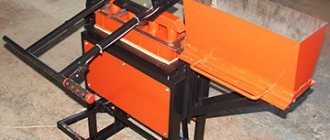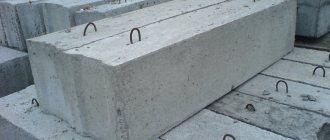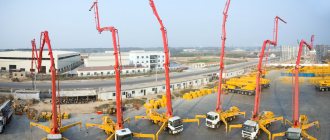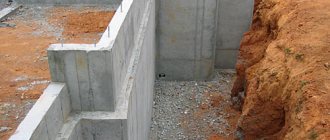Monolithic houses are considered one of the most reliable and durable building structures.
However, their quality directly depends on the condition of the concrete solution used, as well as on how quickly the concrete is delivered to the work site. Concrete mixer trucks are designed for this purpose.
They are specially designed vehicles that transport concrete mixture from the supplier to the construction site, move the solution around the perimeter of the construction site, and also constantly maintain the concrete in a liquid state.
Why do you need a concrete mixer truck?
A concrete mixer truck, otherwise called a concrete mixer, mixer or ABS, is designed for transporting concrete in accordance with GOST requirements.
Thanks to ABS, during transportation the concrete mixture is not exposed to direct sunlight and precipitation does not penetrate into it.
In addition, the concrete mixer prevents the homogeneity of the concrete solution from being disturbed and prevents its loss on the road, as well as during loading and unloading.
The concrete mixer truck itself is a large truck on which an automatic concrete mixer is installed. This vehicle is made specifically for transporting concrete mixture.
Recycling garden waste can be made into an easy exercise by using a grass and branch shredder that has an automatic feed function. From this article you will learn the features of disassembling the hoods of American 9400 tractors.
Concrete is loaded into the machine directly at the manufacturing plant. In its original form, it is a dry mixture, which, after being placed in a concrete mixer, is filled with water and sent to the construction site.
During transportation, ABS mixes the mixture until ready, and then maintains it at the desired consistency and does not allow it to harden until unloading.
In another option, concrete is poured into the mixer in a ready-made state. Then the concrete mixer simply maintains the solution in liquid form.
When choosing a concrete mixer truck, you should take a closer look at the SB-159A model, the technical characteristics of which meet all GOST requirements.
ABS device
A concrete mixer truck is a pear-shaped container with blades inside, which are designed to mix and obtain a homogeneous mixture. The drum is loaded and transported to its destination. The container rotates clockwise. Unloading is carried out when the drum is turned in the opposite direction.
In terms of capacity, the most widely used are drums with a volume of 7 to 9 cubic meters. m. The maximum capacity of mixers is 15 cubic meters. m.
Machine design
In modern car mixers, the reverse principle of operation is most often used. The main working element, the drum, is mounted on the truck chassis. The inside of the drum is equipped with 2 spiral blades. When the blades rotate, the contents of the tank move. When rotating clockwise, the mixture tends to the bottom of the barrel, counterclockwise - towards the exit.
The rotation of the blades is carried out using electric, mechanical or hydraulic drives, depending on the design of the vehicle. The engines operate using power taken from the vehicle itself or from a separate engine. Water containers can be connected to the tank.
The components of the drum also include funnels and special sleeves. With their help, drum materials are loaded and unloaded. On average, the sleeve length reaches about 3 m. There are also special attachments with which you can increase the length by 2 times.
Solution supply
From the concrete mixer, the supply of mortar and mixtures to the pouring sites is carried out in the following ways:
- Short and extended trays for solutions. Small sizes are used if there is access for an automixer to drive directly to the pouring site. Longer ones - if access to the construction site is difficult. The length of this tray can reach 7 m.
- Conveyor belts. This is a conveyor that includes rubber 40 cm wide and up to 14 m long. It has the property of turning in different directions at right angles. Designed to be lifted to a height of up to 4 m.
- Concrete pumps. A concrete mixer with a concrete pump has a boom that pumps the solution in a horizontal and vertical position. The boom is folding, its length can reach 60 m, depending on the design features of the automixer. If the length of the boom is not enough, it is possible to increase it using special hoses, the length of which is 5 m. You can increase it by 4 pieces.
- PUMIK. A machine that combines a concrete mixer and a concrete pump. The advantage is that with its help the mixture can be supplied to a height of 28 m. It works within a radius of up to 24 m.
Who needs concrete mixers?
Concrete mixer trucks are purchased by companies specializing in providing concrete delivery services. Such enterprises fulfill orders for transporting concrete or rent out machines.
This is beneficial, since small construction enterprises simply cannot afford to purchase ABS, or this purchase is simply impractical.
Small organizations are not able to carry out a large volume of work, which means that the concrete mixer truck will only be partially involved in the construction process.
Also, renting a mixer is in demand among individuals who independently carry out construction work.
Truck-mounted concrete mixers are also purchased by large firms engaged in construction on an ongoing basis. In this case, the payback of the equipment is high.
With normal ABS loading, the cost of its purchase pays off within a year, even when taking into account depreciation charges.
The most cost-effective use of a concrete mixer is for the construction of agricultural structures, road work, and also in cases where the construction site is located at a considerable distance from the concrete supplier.
Types of concrete mixers
In order to make the right choice, you need to understand the design of this tool. The photo shows concrete mixers with forced and gravity types of mixing.
Gravity concrete mixers mix the solution using an electric drive. The gravitational influence of the blades turns around and mixes the solution. You can adjust the mixing by tilting the bulb. Simple and inexpensive to use, but the quality of mixing the mixture is slightly lower. Good look for home use.
Forced-action concrete mixers mix the solution with blades in a stationary pear. In this type of concrete mixer, mixtures with fine-grained components are prepared.
This type of mortar mixer is rarely used for individual use due to its high price and expensive repairs.
Design and operating principle
Any concrete mixer has an oblong-shaped mixing drum, reminiscent of a huge pear. This drum is installed on the machine at an angle of 10 to 15 degrees and has a special spiral blade inside.
When the blade rotates, the concrete mixture is pushed to the bottom of the pear, that is, the solution is constantly mixed. All this is done while transporting the concrete to the construction site.
When the truck arrives at the construction site, the process of unloading concrete begins. To do this, the spiral blade inside the drum begins to rotate in the opposite direction.
Under pressure, the mixture is pushed out of the concrete mixer and flows through the gutters to the area needed by the builders. There are two such grooves: one is installed in the concrete mixer itself, and the other is attracted to it from the construction site.
Sometimes it happens that the machine does not have the opportunity to approach the site at the required distance, and the chutes do not reach the unloading point.
In such cases, special pumps are connected to the concrete mixer and flexible hoses or conveyor units are pulled through. This allows you to supply concrete over fairly decent distances.
Types of concrete mixer trucks
All concrete mixer trucks are classified according to the following parameters:
- According to the type of working engine.
There are stand-alone and chassis-mounted engines. An autonomous engine allows you to mix the concrete mixture even when the car itself is out of order.Therefore, it is considered the most reliable for a concrete mixer. The chassis-based engine is lighter, more environmentally friendly, and does not produce much noise.
- According to the type of drive of the mixing drum.
Previously, the mixer was equipped with a mechanical drive, but modern technologies have made it possible to equip almost all concrete mixer trucks with a hydraulic drive. - According to the unloading method.
Backward unloading is very popular; it makes it possible to get close to the desired location and unload the concrete mixture as accurately as possible.Forward unloading allows the driver to control the process directly from the cab.
- By drum volume.
This is the main characteristic of a concrete mixer truck. Vehicles are produced that transport concrete in volumes from 4 to 12 cubic meters.
The most common model is the SB-92 concrete mixer truck, the technical characteristics of which require the use of the Ural base chassis.
Making a concrete mixer
Due to the high price, if you need one-time use, you can make a concrete mixer yourself. To do this, you need to select a container. You can even use a plastic barrel or, if possible, weld a metal tub yourself.
When choosing a base, you need to consider what volumes you will knead and, based on this, use a metal or wooden base.
If you make it yourself, you can install a motor for this - an electric motor from a washing machine will do. Craftsmen even use motors from a moped or motorcycle. You can also set manual rotation. It all depends on your desire and capabilities.
The mixture will cook using either rotation method. In the photo you can see homemade concrete mixers; perhaps they will help you in making your own tool.
Specifications
ABS differs in the following indicators:
- Maximum volume of concrete mixture.
- Maximum weight of concrete mix (with full water tank).
- Weight of the loaded concrete mixer truck, including:
- Total weight of ABS, including:
- load on the front axle(s);
load on the front axle(s);
load on the rear axle (trolley).
load on the rear axle (trolley);
water tank capacity.
The modern ABS model range includes nine types of machines with drum volumes of 4,5,6,...,11,12 cubic meters.
Vehicles capable of holding up to 15 cubic meters of concrete are produced to order, but ordinary buyers mainly purchase concrete mixer trucks with drum volumes of 5.7 and 9 cubic meters.
Many different modifications are applicable to the main ABS model range. The changes relate to the hydraulic transmission and the installation of water tanks of different capacities.
It is possible to change the mixing drums and the concrete mixer control system, as well as improve the autonomous motors and water supply.
Technological equipment can be mounted on the chassis of a domestically produced vehicle and foreign-assembled vehicles.
The most popular Russian brands are considered:
- KAMAZ;
- Ural;
- MAZ;
- KrAZ.
Most often, a concrete mixer truck is placed on the KamAZ-6520 base, the technical characteristics of which are suitable for this installation.
Foreign cars:
- MAN;
- Volvo;
- Scania
- Mercedes-Benz;
- Iveco;
- Renault;
- Ford.
Additional functions
Most truck-mounted concrete mixers have a function that allows you to weigh and dose the ingredients of the building mixture. Thanks to this, the final result is a composition that is ideally suited in terms of its characteristics to a particular customer.
In addition, special equipment that automatically regulates the composition of the concrete solution allows the use of a concrete mixer truck for better road construction and repair.
The weighing system of some ABS contains a load cell built into the hydraulic system of the drum. It weighs the concrete components as they enter the cavity, and as soon as the required volume of materials is reached, an audible alert sounds.
In more expensive automatic concrete mixers, several strain gauges are installed, which make it possible not only to determine the mass of all components of the building mixture, but also to regulate their quantity during mixing.











